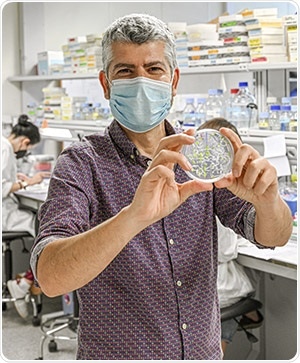An international research team led by the Institute of Molecular and Cellular Biology of Plants (IBMCP), a collaboration between the Universitat Politècnica de València (UPV) and the Spanish National Research Council (CSIC), has found that a genetic pathway known as CHLORAD, which is implicated in the aging of plant leaves, also plays a critical role in the ripening of tomatoes.

Manuel Rodriguez Concepción, researcher at the IBMCP. Image Credit: Universitat Politècnica de València.
As a result, tomatoes with an active CHLORAD system turn red faster and absorb more lycopene, a health-promoting chemical. The findings, which were published in the most recent issue of the journal Nature Plants, would lead to higher-quality tomatoes.
Many fleshy fruits ripen to attractive colors and smell as they ripen, which is a plant trick to disperse the seeds more widely and colonize new territories. Ripening tomatoes change their color from green to orange and red.
The green color is caused by the existence of chlorophyll (the photosynthesis pigment) in the immature fruits’ chloroplasts. When they ripen, the chloroplasts (photosynthesis organs) lose the chlorophyll and release a huge number of other pigments known as carotenoids.
Tomato carotenoids are orange (from beta-carotene) and red (from lycopene), causing the fruit to turn orange when ripe. Furthermore, these carotenoids produce aromas that lead to the distinctive smell of ripe tomatoes. To do this, the chloroplasts must be converted into a new kind of carotenoid storage compartment known as a chromoplast.
It was previously unknown how the tomato plant regulates the transition of chloroplasts to chromoplasts. In an article written in the journal Nature Plants, a research team from the University of Oxford (UK) in association with the Valencian Institute of Molecular and Cell Biology of Plants (IBMCP) has unraveled much of this mystery.
The key to this study comes from Arabidopsis, a plant used as a research model, which does not spontaneously grow chromoplasts but does turn the chloroplasts during a process called leaf senescence, in which the leaves mature, lose chlorophyll, and cease photosynthesizing.
During this process, a molecular mechanism known as CHLORAD eliminates complexes in the outer layer of chloroplasts that import photosynthesis-related proteins.
Tomatoes that turn red sooner
The CHLORAD method, according to researchers, also functions during tomato ripening. When activated, it inhibits the import of photosynthetic proteins while promoting the integration of other proteins required for the storage and production of carotenoids during the chloroplast-to-chromoplast transition.
Thus, fruits with an active CHLORAD system ripen faster and accumulate more of the health-promoting carotenoid lycopene, while fruits with an impaired CHLORAD system ripen later.
In addition to better understanding how chloroplasts are transformed into chromoplasts, we now know that this process not only regulates fruit pigmentation, but also affects many other aspects linked to ripening that influence the firmness or the aroma of tomatoes.”
Manuel Rodríguez Concepción, Researcher, Spanish National Research Council, Institute of Molecular and Cellular Biology of Plants
The hurdle now is to understand the links between these mechanisms to produce tomatoes of higher nutritional and commercial quality while retaining their distinctive flavor, aroma, and color.
Source:
Journal reference:
Ling, Q., et al. (2021) The chloroplast-associated protein degradation pathway controls chromoplast development and fruit ripening in tomato. Nature Plants. doi.org/10.1038/s41477-021-00916-y.